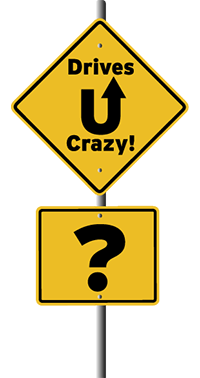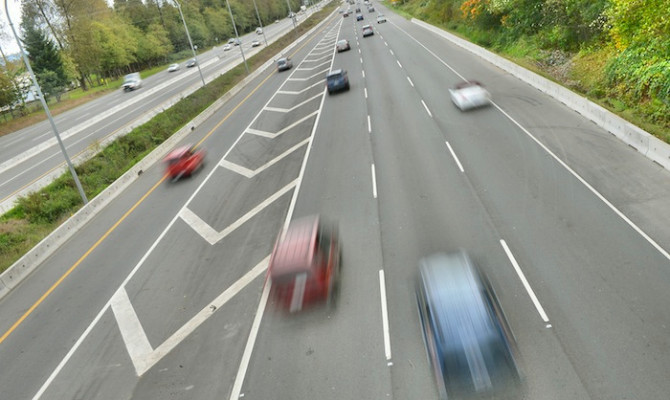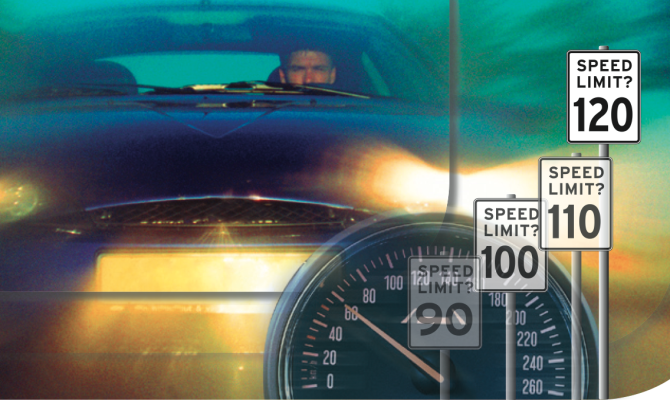Simple math and rudimentary physics teaches us that the harder people hit, the harder they fall…
B.C. drivers are getting used to a faster life in the fast lane very quickly.
News of the hike of 10 km/h to the posted speed limit on long stretches of major highways was announced swiftly the other weekend, taking many by surprise.
By Sunday, I was taking a 2014 Toyota Highlander for a faster spin on the Okanagan Connector/Coquihalla Highway route than I had expected when I headed to Kelowna days earlier. What was still more surprising was that the signage reflecting the higher speed limits was already up. (I’ve never see the provincial government bureaucracy move so fast!)
This was not going to be a trip to try to prove or disprove Toyota’s boast that the 3.5-litre V6 under the hood would, with the aid of the six-speed auto transmission, transport me to the coast sipping just 8.2-litres for every 100 klicks travelled. No, I would be calling on all 270 horses to do more than canter up those steep hills that separate the Okanagan from the Lower Mainland.
Climbing to the Pennask summit was a quiet and fast run. The cruise control was set to the maximum limit of 120 km/h… and I was passed by everyone on the road!
Some things don’t change. Hike the limit and most drivers will tack on another 10 klicks. I passed a few nervous folks, who seemed determined to stick to the defunct maximum of 110.
Speed differential is what causes big problems on the highway. If there is a wide variation and people are not showing lane discipline i.e. keep right unless passing, that’s a recipe for disaster as impatience and frustration takes over.
I tacked on another five klicks so as not to be too far out-of-sync with my fellow travellers. However, along stretches of the Coquihalla, my 125 wasn’t enough to satisfy the need for speed exhibited by many others. On the straights, 130 was the low end and I figure that most who passed me were travelling at nearer 140. The descent to Hope was like a racetrack but then it always is.
In the days that followed, the anti-speed lobby woke up and took to the airwaves with dire warnings of increased carnage. Simple math and rudimentary physics teaches us that the harder people hit, the harder they fall. Let’s hope the poor driving practices that lead to such collisions don’t increase and reprove such a simple truth.
P.S. I achieved 9.5 L/100km on the journey home.
 Reader Telina Muyres wishes drivers would accelerate to the speed of highway traffic when merging.
Reader Telina Muyres wishes drivers would accelerate to the speed of highway traffic when merging.
“It makes it dangerous when they’re going 40,60 or 80 . . . . (the speed lmit) is 100, people!”
What drives-u-crazy? (more…)
Increasing the speed limits will only increase risk to all road users, they say…
Driveway readers have the final word on the posted speed limit poll, conducted in partnership with Insights West.
In that survey it was revealed that 37 percent of those polled believe a higher than 100 km/h limit should be posted on our major highways. The provincial government current review of speed limits has already prompted much public discussion, much of which seemed to support the hiking of limits. With that in mind, we were surprised that the poll showed that 55 percent believed speed limits should be left alone.
Here’s further reaction posted online by readers…
For an increase in limits:
Kmac: “Excessive speed, texting and using a cell phone while driving, driver in attention and driving too fast for the road &/or weather conditions kills. The minimal increase in the speed limits you suggest make sense.”
efi1936: “I think that the Coquihalla should be 130 km/h and the rural part of Highway 1 120km/h.”
lyle: “As stated in your column, it is only excessive speed that kills. However, if two drivers were driving side by side at 100 km/h there would be mass frustration and more accidents.”
CaryAnn: “I think the majority of drivers driving today are totally conscious of their vehicle and surroundings and are very capable of handling the higher speeds.”
DriveSmart: “Maybe the new limit should be displayed on new variable signs so that it can be adjusted downward in darkness and poor driving conditions.”
28speedster: “Here we are in the 21st century driving at the same or lower speed limits than we did with cars in the 1950s with bias ply tires on two-lane highways. New cars, tires, roads are engineered for much higher speeds. A higher speed limit will require drivers to pay attention to their driving.”
Mark: “Being from Germany and having driven faster and safely on the Autobahn, I say it’s about time. When I took my driver’s test, part of the test was on the Autobahn and you had to go 130km/h (weather and local speed limit permitting) NOT to get points against you.”
Comments against an increase:
Dwsolber: “Some drivers have trouble driving safely at current posted speeds. Increasing the speed limits will only increase risk to all road users.”
Dick: “Do not increase speed, what the heck is the hurry? (99 out of 100 already go way faster than the posted speed. Make your ride safe and enjoy the scenery.”
Leah99: “Wildlife (and domestic pets), pedestrians, and vehicles driven by law-abiding people are put at risk by speeders as it is.”
Donna: “There are enough accidents at 110 without increasing the risks.”
Snazzy: “Speeds above 90km/h greatly increase fuel consumption. In addition to lower speeds being safer for drivers, wildlife, it is also important that we consider the planet, and reduce our use of fossil fuels.”
Rosemary: “In BC’s interior, there are many hazardous roads and bad weather conditions, but drivers in general ignore them. If you ‘up’ the speed limit, they will ‘up’ the speeding… What ever happened to safe driving? Like reducing speed at night when visibility is reduced?”
Brian: “People already drive 10 to 20 above the speed limit . . . if you raise to 120 they will go up to 140.”
Variable speed limits are used throughout Europe and seem effective…
Reader reaction to our posted speed limit poll, conducted with Insights West, was… well, speedy!
No sooner had the paper hit the streets – revealing that 37 per cent of those polled believe a higher than 100 km/h limit should be posted on our major highways – than the emails began flying.
Yours truly expressed some surprise that a majority did not share that opinion, and that 55 per cent believed speed limits should be left alone. While some readers disabused me of that notion, an equal number agreed.
Guenter Hoernig of Penticton asked, “What would you gain by, say, increasing the limits by 10 or 20 km/h? A half an hour earlier in Vancouver? Well, if you don’t have that extra 30 minutes, perhaps you should take the plane.
“I don’t even understand why the public is consulted on this – as any results coming forth from them tend to be purely based on emotions. The safety of the highways should be left to traffic experts and scientists…”
Janet McGarry warned: “NASCAR inspired highways will only lead to more fatalities.”
Currently, 100 km/h is the maximum on most freeways, while 110 km/h is posted on the Coquihalla Highway and parts of the Okanagan Connector.
Vernon resident Brian Romaine made an interesting suggestion: “My view is that the speed sign should have a range of speed, for example instead of say 100 km/h, make it 80 to 100 max. From a psychological point of view, the driver then sees the lower speed and perhaps would have less of a fixation on the max speed limit. Speed limits should be assessed by the experts to be safe for that particular highway and not necessarily increased.”
Variable speed limits are used throughout Europe and seem effective. The maximum limits are posted on overhead electronic signs, which change to reflect environmental conditions and congestion. It is a recognition that speed alone is not the major cause of road carnage but excessive speed combined with over-driving the weather/road conditions does kill.
The provincial government is currently reviewing posted limits and Jack Dubberly believes Victoria should hike them forthwith.
“If the roads are better engineered, cars are safer… then why not increase the speeds to that ‘average comfortable speed’ that everyone is travelling at when the police are not looking?
“The police can spend more time looking for bad drivers rather than speeding drivers and maybe the general driving public will then respect them more.”
Laura Tomelin shared her driving philosophy: “Do not drink and drive, but drive at your own capabilities and get the hell out of the way of other drivers who take their own risks and feel comfortable doing so!”
The more cynical of our readers, dismissed the current posted speed limits as being artificially low and designed not for safety reasons but as a way of generating cash for the government through fines.
Transportation Minister Todd Stone will give BC residents an opportunity to express their views directly in a series of eight regional public forums set to run between now and January 24, 2014. For details of the Rural Highway Safety and Speed Review, check it out online.
More than half of those polled believe the province should not bring back photo radar… (more…)
Recent Comments
- { Enjoyed your Forest of Bowland in the BMW X5M, particularly the photo of the BMW in front of the main part of Stonyhurst College where... }
- { Bantam designed the Jeep, not Willy's or Ford. The American military gave the original Bantam prototype to Willys and Ford to copy. There is plenty... }
- { All Escalades come with a 6.2-lilter V8 engine that produces 420 horsepower. A six-speed automatic is the only transmission offered and drives the rear wheels.... }
- { Alexandra is an excellent journalist. }
Popular Posts
- Journey to a ‘Sparkling’ Luxury Okanagan Resort “Four lucky readers will put a Dodge Journey’s weekend-...
- The Need For Speed: Hike Those Highway Limits More than half of those polled believe the province sho...
- Drives-U-Crazy… Erratic drivers. An early morning drive from Kelowna to Vancouver is nor...
- Readers Respond: The Pros and Cons of Increasing B.C. Speed Limits Increasing the speed limits will only increase risk to...
- Honda CR-V Review: The Compact Crossover To Get Things Done The CRV is a very stylish and aerodynamic crossover veh...










